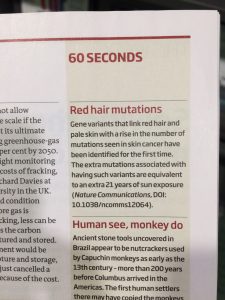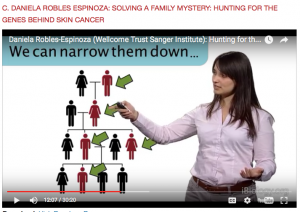Our new publication is hitting the international news!
Our last publication came out earlier this week:
Robles-Espinoza CD, Roberts ND, Chen S, Leacy FP, Alexandrov LB, Pornputtapong N, Halaban R, Krauthammer M, Cui R, Timothy Bishop D, Adams DJ (2016). Germline MC1R status influences somatic mutation burden in melanoma. Nat Commun. Jul 12;7:12064. doi: 10.1038/ncomms12064. PMID: 27403562
Here is a link to the paper in the Nature Communications website, and here a link to the press release by the Sanger Institute. In this paper, we describe one of the first common genetic profiles (common variants in MC1R, a gene which controls pigment production) having a large impact in the somatic burden of a tumour (melanomas). People with two MC1R variant alleles usually have red hair, but people with one MC1R variant allele are not redheads and most probably don’t know they are carriers. In this study, we observe that melanoma tumours from people with one variant MC1R allele have 42% more sun-associated mutations in their tumours than people with no MC1R variant alleles, which is comparable to the figure obtained in 21 years of age. Thus, the message is that everyone needs to be careful in the sun, as you might be at elevated risk and not know it!
We are very impressed and pleased by the reception it has had by the international press! It was reported by the BBC and The Guardian (overall the best reporting in our opinion), The Times, the Washington Post, the Los Angeles Times, the Telegraph, Reuters, Elite Daily, the Weather Channel, Haaretz, The Mirror, The Sun, the Scientist, the Daily Mail, the Evening Standard, the Huffington Post, the Independent, Yahoo News, The New Zealand Herald, the Japan Times, the Irish Post and the NBC Today, among others. We also found good analyses in Spanish, by Ciencia Xplora and Que.es. We found that it even made it to the television news in Fox! The British National Health System provided a good analysis of the claims made by the press and the actual science in the paper. However, we are very happy that the point of the message got across in almost all of these stories.
Dave (Sanger Institute) and Tim (University of Leeds), who supervised the work, gave radio and TV interviews to the BBC Cambridgeshire, BBC Look North and Radio Wales. Daniela gave an interview to the beauty magazine Allure, who transmitted the message accurately.
It was also reported by the popular science news outlet I F*cking Love Science. It reached 11,100 shares in 3 days!

<– We even found it in the printed version of New Scientist magazine! (Thanks to Dave for the photo).
So, overall, we are quite happy with the media response – most of the outlets reported the research accurately and transmitted the important public health message 🙂

